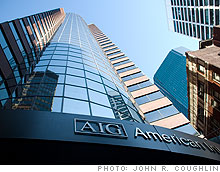The messy issue of 'too big to fail'
Congress and regulators are pushing for a fix to the problem of mammoth financial firms needing bailouts, but experts say there is no easy solution.
 |
| AIG has become the poster child for the 'too big to fail' concept after multiple rescue efforts in the past year. |
NEW YORK (CNNMoney.com) -- Lawmakers are quickly learning that "too big to fail" may be too complex to legislate away.
The issue of determining which financial firms are worthy of a government rescue, which first took hold when the credit crisis intensified last fall, has been a subject of persistent -- and divisive -- debate.
Top regulators at the Treasury Department and Federal Reserve were widely criticized after making the difficult decision to let Lehman Brothers file for bankruptcy, while stepping in more than once to bail out insurer AIG (AIG, Fortune 500).
The topic has taken center stage in Washington recently as the debate on regulatory reform picks up speed on Capitol Hill.
One of the biggest challenges facing lawmakers, experts argue, is determining which companies are so important that their downfall would have disastrous implications for the financial system and entire U.S. economy.
In addition to AIG, the government has propped up big banks such as Citigroup (C, Fortune 500) and Bank of America (BAC, Fortune 500) with multiple capital injections.
Each bank has received $45 billion from the Treasury Department as part of the Troubled Asset Relief Program, or TARP. Taxpayers now own more than a third of Citi following a conversion of part of the government's preferred shares into common stock.
At the same time, the Obama administration looked the other way when the smaller commercial lender CIT (CIT, Fortune 500) was teetering on the brink earlier this month.
But determining who makes the cut shouldn't be based simply on size, said Peter Wallison, a fellow in financial policy studies at the American Enterprise Institute. He noted that even small, seemingly innocuous firms can pose a risk to the financial system.
"The major problem with 'too big to fail' is that we don't really know when an institution is too big to fail," said Wallison.
The notion of creating of a list of systemically important institutions appears to have the backing from the Federal Deposit Insurance Corp. and the White House, but there have already signs of a pushback from Congress.
Rep. Barney Frank, D-MA, whose House Financial Services Committee will likely impose a heavy hand on any forthcoming regulatory legislation, warned earlier this week that creating such a list would encourage the very problem that regulators have sought to stamp out.
"It would be kind of a license to do well because people would think you couldn't fail," he said.
Many have cited the implicit government guarantee behind mortgage giants Fannie Mae and Freddie Mac as helping to fuel problems there. Because there was a widely-held belief that regulators wouldn't allow Fannie and Freddie to collapse, the two firms took on sizeable risks during the housing boom.
Fannie and Freddie eventually grew to such mammoth proportions that the government was ultimately forced to seize control of them nearly a year ago to prevent them from completely going under.
But even if lawmakers are able to agree on who is and isn't too big to fail, there are several other complicated issues for Congress to consider.
One nagging question is determining just how to let a failed financial institution go under without causing a major disruption to the financial system. Many blamed the lack of such a mechanism for regulators' inability to dismantle AIG last fall once they learned just how grave the insurer's health was.
One leading proposal would entail creating a system similar to how the FDIC handles failed banks. In such cases, the agency takes control of a failing institution, often with a buyer already in place for all of its assets.
Bipartisan legislation put forth this week by Sen. Bob Corker, R-Tenn. and Mark Warner, D.Va., would effectively allow the FDIC to do the same thing with large, complex financial firms that are organized as bank holding companies.
Still, there are questions about whether money should be set aside in the event a systemically important company goes under and how to fund such a reserve.
Taking a page from her agency's own playbook, FDIC Chairman Sheila Bair proposed last week that a fund paid for by large financial companies be created in order to avoid needing more bailout money from the U.S. taxpayer.
But this plan would likely meet plenty of resistance from those who would bear the biggest costs, the financial services companies themselves.
George Kaufman, a professor of finance and economics at Loyola University Chicago, added that lawmakers would also need to decide whether firms be charged before, or after, a troubled institution goes under.
"If you do it [afterwards] then you let the guilty party escape without paying," Kaufman said.
Regardless of how the issue is resolved, it is clear that the government needs to find some way to let major financial firms go under without feeling as if they are putting the economy at risk.
"We must find ways to impose greater market discipline on systemically important institutions," Bair told lawmakers last week. "Unfortunately, the actions taken during the past year have reinforced the idea that some financial organizations are too big to fail."
Talkback: Should the government allow even the largest financial firms to go under or do you think there is such a thing as a bank that is too big to fail? Share your comments below. ![]()

